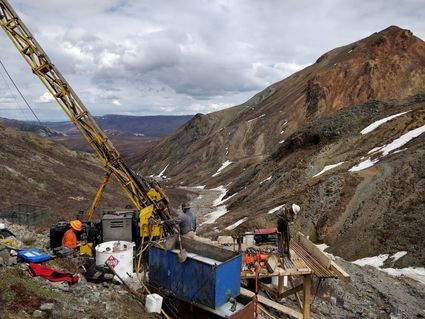Aussie explorers ready for Alaska summer
North of 60 Mining News – April 12, 2019
Last updated 9/25/2020 at 2:39pm

White Rock Minerals Ltd.
This hole, drilled at Dry Creek, cut 8.9 meters of massive sulfide mineralization averaging 6.5 percent zinc, 2.7 percent lead, 124 g/t silver, 0.7 g/t gold and 0.2 percent copper.
White Rock Minerals Ltd. April 9 reported that following the March 25 signing of a joint venture with Sandfire Resources, the two Australian companies are already gearing up for an exciting 2019 field season at the zinc-rich Red Mountain project about 60 miles (100 kilometers) south of Fairbanks, Alaska.
Two deposits already identified on the property – Dry Creek and West Tundra Flats – host 16.7 million metric tons of inferred resource averaging 4.1 percent (1.49 billion pounds) zinc; 1.7 percent (630 million lb) lead; 0.2 percent (57.3 million lb) copper; 99 grams per metric ton (53.5 million ounces) silver; and 0.7 g/t (352,000 oz) gold.
A technical committee comprised of representatives from White Rock and Sandfire have approved an AU$6 million (US$4.3 million) program for 2019 that aims to drill as many new targets as possible across the 475-square-kilometers (117,375 acres) Red Mountain property.
"Having the technical and financial support of Sandfire Resources – a very successful explorer and developer of VMS deposits – is a strong endorsement to the quality and potential of our Red Mountain project," said White Rock Minerals CEO Matt Gill.
To help narrow down targets for the drills, the JV partners have decided to kick off the 2019 program with a 3,000-line-kilometer airborne electromagnetics survey. Expected to get underway by mid-April, this new SkyTEM survey will be the first modern high-powered time-domain electromagnetic survey at Red Mountain.
With the capability of identifying conductivity anomalies to depths of 400 meters, Red Mountain and Sandfire believe this geophysical survey could fast-track a significant new discovery.
"To be able to use a modern high-powered geophysics technique for the first time, not previously applied to this highly prospective field, is a great kick-off to this field season," said Gill.
Other work being carried out to develop targets for this summer's drilling include:
• satellite spectral analysis, including the assessment of hyperspectral data to identify and map alteration zonation ahead of field exploration;
• regional whole rock lithogeochemical analysis of tenement-wide rock chip samples collected in 2018 and accessed from the Alaskan geologic survey to identify regional alteration zonation to assist in prioritizing targets;
• detailed on-ground geological reconnaissance and soil geochemical sampling across regional target areas using a portable XRF (x-ray fluorescence) analyzer to deliver rapid target definition; and
• electrical ground geophysics across the regional targets using techniques that successfully mapped conductivity associated with mineralization at Dry Creek and West Tundra Flats.
The Hunter discovery will be the first target of the 2019 drill program, which is expected to get underway by the end of May.
Reconnaissance exploration carried out by White Rock crews in 2018 discovered a two-foot massive sulfide outcrop at Hunter rich in sphalerite (zinc mineralization) and galena (lead mineralization).
Further prospecting at this new zone about 5,200 meters southeast of Dry Creek mapped massive sulfide mineralization for about 500 meters along strike and identified evidence that this VMS target could extend for more than 1,000 meters.
The discovery hole, HR18-01, cut 1.4 meters of massive sulfide averaging 17.4 percent zinc, 3.9 percent lead, 90 g/t silver and 1.6 percent copper, or 25.8 percent zinc-equivalent.
HR18-02, drilled from the same pad at a shallower angle, cut 1.8 meters averaging 13.8 percent zinc, 3.1 percent lead, 56 g/t silver and 0.9 percent copper, or 19.5 percent zinc-equivalent.
In addition to following up at Hunter, the 2019 drill program will test the best regional targets defined by the airborne geophysics; satellite defined alteration; 2018 stream geochemical anomalies; sampling; and ground geophysics.
White Rock is currently readying the camp for what is expected to be a busy 2019 field season at Red Mountain.

White Rock Minerals Ltd.
This two-foot massive sulfide outcrop rich in sphalerite (zinc mineralization) and galena (lead mineralization) was discovered at the Hunter prospect during White Rock's 2018 reconnaissance exploration at Red Mountain.
"We look forward to working with our strategic JV partner and progressing this highly prospective project with the commencement of this program and the subsequent news flow that should result," Gill said.
–SHANE LASLEY





Reader Comments(0)